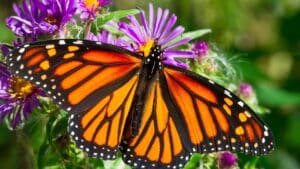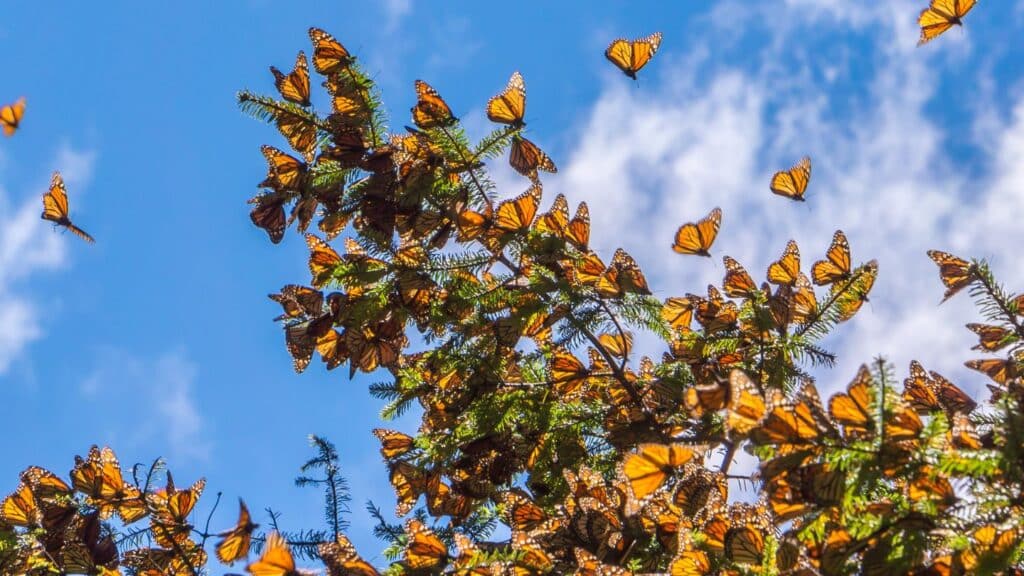
Help Monarch Butterflies Thrive in Your Landscape
The majestic monarch butterfly, known for its beauty and incredible migration journey, is facing a concerning decline in population. Although there are monarch populations that overwinter in North America there is recent data from Mexico, a crucial wintering ground for the eastern monarch population that paints a particularly alarming picture.
A Dramatic Decline in Mexico:
- 59% Drop in Population: The 2023-2024 winter season saw a shocking 59% decrease in the area occupied by monarch butterflies in central Mexican forests compared to the previous year. This represents the second-lowest population level ever recorded, highlighting the urgency of the situation.
- Heat, Drought, and Habitat Loss: Experts attribute the decline to a combination of factors, including extreme heat and drought conditions in the butterflies’ breeding grounds in North America, which limited milkweed availability, their sole food source for caterpillars. Additionally, habitat loss due to deforestation in Mexico further threatens their overwintering survival.
What You Can Do in Your Landscape:
While the challenges faced by monarchs are extensive, individual actions can contribute to their conservation. By creating a haven for them in your landscape, you can provide essential resources and support their recovery:
-
Plant a Monarch Butterfly Garden:
- Focus on Milkweed: Choose native milkweed species suitable for your region, as they are vital for caterpillar development.
- Offer Nectar Sources: Plant a variety of flowering plants that bloom throughout the season, providing adult butterflies with energy. Consider native wildflowers, butterfly bushes, and coneflowers.
- Create a Diverse Habitat: Include various plant types and heights to offer shelter, nesting sites, and basking areas for monarchs.
-
Embrace Sustainable Practices:
- Avoid Pesticides and Herbicides: These chemicals harm not only butterflies but also the insects they rely on for food. Opt for organic gardening methods and natural pest control solutions.
- Provide Overwintering Sites: If you live in a warm climate, consider planting native trees and shrubs that offer protection from wind and cold.
- Let Your Garden Flourish: Avoid excessive trimming and mowing, allowing some areas to grow wild and provide natural habitat elements.
Spreading Awareness and Taking Action:
- Educate Others: Share your knowledge about monarch butterflies and their needs with friends, family, and neighbors. Encourage them to create butterfly-friendly gardens as well. These areas will likewise benefit other pollinator species.
- Support Conservation Efforts: Donate to organizations working to protect monarch butterflies and their habitat, such as Monarch Watch, The Xerces Society, and The World Wildlife Fund.
By taking these steps, you can become part of the solution and contribute to the conservation of this iconic butterfly species. Remember, every action, no matter how small, can make a difference. Even a single butterfly garden can provide essential resources for monarchs, and the collective efforts of individuals like you can create a network of habitat that can significantly impact their survival. Additionally, by spreading awareness and supporting conservation organizations, you can amplify your positive influence and inspire others to join the cause. Together, we can create a future where these magnificent creatures continue to grace our skies and inspire us with their beauty and remarkable journey.
From our office in Atlantic Beach and satellites throughout Northeast Florida, Rockaway Inc proudly serves both commercial and residential sustainable landscape design, maintenance, lawn care, irrigation, and outdoor living carpentry client needs in Jacksonville, St Augustine, Atlantic Beach, Neptune Beach, Jacksonville Beach, Ponte Vedra, Nocatee, St. Johns, and Fernandina Beach.
